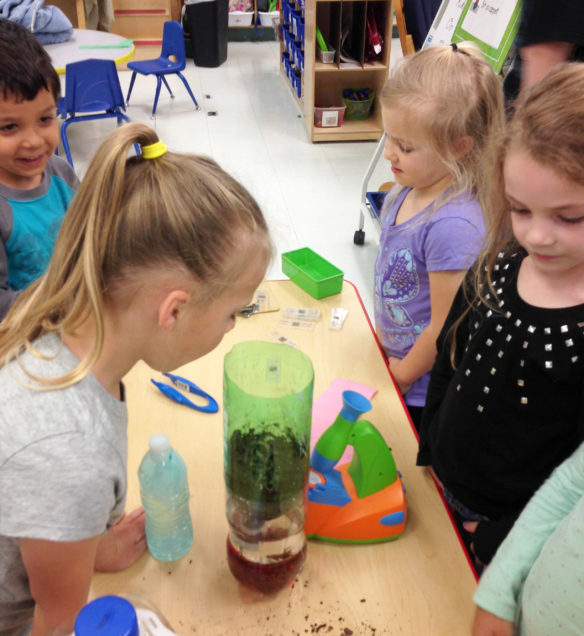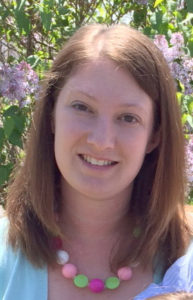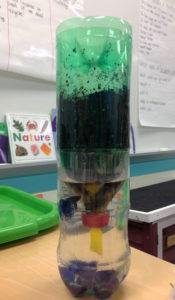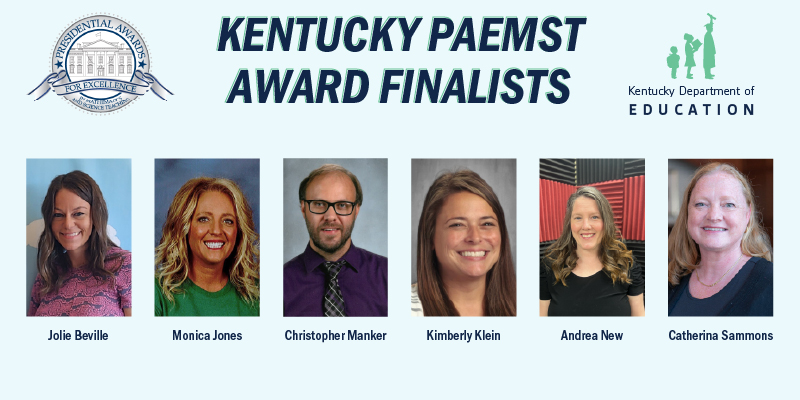
Students at Rich Pond Elementary School (Warren County) use tools in the science center to examine the earthworms in the ecosystem they helped build.
Photo submitted by Christina Sanders
By Christina Sanders
christina.sanders@warren.kyschools.us
Preschool children possess a natural wonder and curiosity, which allows ordinary life experiences to become extraordinary opportunities for learning. By making connections between ecosystems and conservation through the construction of a recycled bottle ecosystem, preschoolers discover the intricacies of living things in a hands-on way that allows them to direct their own learning.

Christina Sanders
Aquaponics combines aquaculture (the cultivation of fish or other aquatic species) with hydroponics (the practice of growing plants in only water) in a self-sustaining system. The wastewater from the fish is recirculated to water and fertilize the plants and the runoff from the plants provides a food source for the fish.
Aquaponics systems can be elaborate or they can be constructed from very basic materials, as is the case with the recycled bottle ecosystem. The ecosystem is not a true aquaponics system, as it utilizes soil for the growth of the plants to allow for the introduction of earthworms, adding another element to the ecosystem.
When constructing the ecosystem, preschoolers are involved in every element with the exception of cutting the plastic bottle, which requires the use of a razor knife or sharp scissors and should be completed by an adult.

This example of a recycled bottle ecosystem was completed by a class of 3- to 5-year-old preschoolers with minimal adult assistance.
Photo submitted by Christina Sanders
To assemble the structure, cut the neck and a 3- to 4-inch section of bottle from an empty, clean 2-liter plastic bottle. Leaving the cap in place, cut a small hole in the cap using a razor knife or drill bit. Fill the bottom of the bottle with water and aquarium gravel or stones to become the habitat for the fish. Because this system is small and does not incorporate a sophisticated recirculation system, only one fish should be housed in each ecosystem. A betta or similar fish is preferable to a goldfish, which create large quantities of waste.
Thread a piece of cotton string through the hole in the bottle cap, then invert the neck of the bottle into the bottom section of the bottle (now the fish habitat). Fill the upturned neck of the bottle with well-moistened potting soil and two or three earthworms. The string acts as the circulation portion of the ecosystem, wicking water from the fish habitat to maintain moisture in the soil. The hole in the cap allows particles of waste created by the earthworms to filter down, providing a food source for the fish. Finally, fill the top soil-filled section of the bottle with seeds to complete the ecosystem.
While assembling the ecosystem, preschoolers access their prior knowledge of the properties of living things. This is a good opportunity to revisit similarities and differences in plants and animals, and living vs. nonliving things. The plastic bottle component can jumpstart or extend investigations of how trash and recycling affect the environment and the impact on plants and animals.
As students study the ecosystem during their daily explorations, journaling provides the opportunity for students to record observations they make regarding the lifecycle of the plants contained in the ecosystem as well as the relationships between each of its components. This long-term project also allows teachers to assess each of the benchmarks of the Kentucky Early Childhood Science Standards using multiple measures – such as anecdotal records, student work samples and audio/video recordings – continuously over an extended period of time to accurately measure students’ understanding of these concepts.
By involving children in their learning and centering on concepts that are interesting and meaningful to them, the assessment data will be reflective of students who are active and engaged learners with a rich understanding of the content.
Christina Sanders is a preschool teacher at Rich Pond Elementary School (Warren County), where she holds the distinction of being a Kentucky Preschool Classroom of Excellence. She has been teaching preschool for 10 years in the public school setting and has 14 years of experience in early childhood education, including authoring a children’s book. She received a bachelor’s in interdisciplinary early childhood education from Western Kentucky University and a master’s in teaching in special education-LBD from The University of the Cumberlands. She is currently pursuing National Board certification as an early childhood generalist.




Christina,
Excellent example of the quality of teaching and learning that occurs in your classroom on a daily basis! Thank you for your willingness to share with other teachers across the Commonwealth!